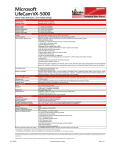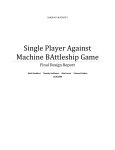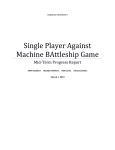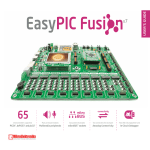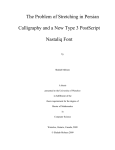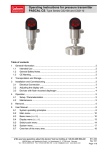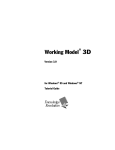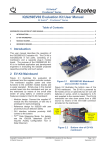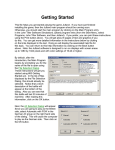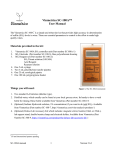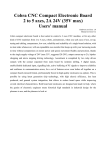Download Single Player Against Machine BAttleship Game
Transcript
HARDING UNIVERSITY Single Player Against Machine BAttleship Game System Design and Project Plan Matt Goodhart Timothy Hoffmann Matt Lewis Tatiana Zeledon Table of Contents System Design ............................................................................................. 3 Background ....................................................................................... 4 System Overview ............................................................................... 4 Block Diagram .................................................................................. 6 Functional Description of Blocks ..................................................... 7 Project Plan ............................................................................................... 11 Organization and Management ..................................................... 12 Work Breakdown Structure – Fall 2009........................................ 13 Work Breakdown Structure – Spring 2010 ................................... 15 Estimated Costs ............................................................................... 18 Gantt Chart – Fall 2009 .................................................................. 19 Gantt Chart – Spring 2010 ............................................................. 20 Network Diagram – Fall 2009 ........................................................ 21 Network Diagram – Spring 2010.................................................... 22 Appendices ................................................................................................ 23 Appendix A – Budget References ................................................... 24 Appendix B – Requirements Specification .................................... 33 2 System Design 3 Background Battleship® is a very popular game around the world whose origin dates back to the early 1900’s when it was invented by Clifford Von Wickler. However, he never patented the game and it was trademarked and commercially produced by the Milton Bradley Company in 1943 as a paper and pencil game. By the 1960’s, and perhaps earlier, a player was able to purchase prepared paper sheets for the game. Since the beginning, letters were printed in the outer vertical edges of the sheet and numbers were printed horizontally at the top. In 1967, the board game of Battleship® was created. The pencil and paper were discarded and were replaced with plastic ships, pegs, and trays. Later, in 1983, the Milton Bradley Company improved the version and included electronic components and new features such as lights and sound. In 2008, the latest version of Battleship® called ‘The Tactical Combat’ was introduced and it includes several modifications to the existing version such as the shape of the ships and board. The Milton Bradley Company has being the only company to continuously produce a Battleship® game for any extended period of time. Our motivation is to create a technically challenging, semi-automated version of the game Battleship® in order to promote the interest of future Harding students into the engineering program. System Overview Our goal is to create an essentially hands-free version of the classic Battleship® game. The game will be powered through a standard 110 V AC household outlet. There will be a keypad that will receive input such as accepting the coordinates of the player’s moves. Also, there will be an LCD screen that will provide feedback to the user and will prompt the user with instructions and notifications, such as when to make a move or indicate when the player has sunk one of the computer’s ships. Beginning game play will require the player to physically place his/her ship pieces on the lower display board. The player then indicates to the computer that this has been done, and the game begins a random selection of who (player or computer) goes first. This selection will be indicated on the LCD screen. On his/her turn, the player inputs his/her move. The microprocessor then discerns if the input was a hit or miss and gives the corresponding output on 4 the upper display. Outputs include lighting a red LED (hit) or a green LED (miss). On the computer’s turn, a plunger/button system moves and senses whether there is a ship in that coordinate or not, and shows its output on the lower display by placing a red (hit) or green (miss) ball via the ball manipulator into the selected spot. This process is repeated until the computer determines that all the player’s ships have been sunk or all the computer’s ships have been sunk. Whenever one of these two scenarios takes place, the game is over. At this point, the user will see where the computer’s ships were as indicated by red LED’s on the upper display of the board. Results will be displayed until the on/off switch is pushed. Our prototype will be delivered as a fully functional battleship game. The top half may be closed and latched so that it may be transported. 5 Block Diagram Single Player Against Machine BAttleship Game Matt Goodhart, Timothy Hoffmann, Matt Lewis, Tatiana Zeledon 6 Functional Description of Blocks Module I/0 System Inputs Power 5V DC and 25mA – Keypad Power 5V DC and 25mA – LCD for power Power 1V DC and 25mA – LCD for contrast User Input Digital signal to LCD from microcontroller – 0 or 5V DC and 0 or 25mA Outputs LCD text Digital signal from keypad to microcontroller – 0 or 5V DC and 0 or 25mA Functionality The user will place his/her move by inputting it on the keypad that looks similar to the keypad on a phone. The numbers A-J will correspond to the numbers 1-10 such that 1=A, 2=B, etc. Each button will have both the number and letter printed on it. The computer will prompt the user to select a letter and the user will input a letter. The computer will then prompt the user to select a number and the user will input a number. Those two signals will be sent to the microcontroller as the user’s move. The LCD screen is the microcontroller’s way of talking to the user and telling him/her what to do. Module Power Supply Inputs Power 110V AC Grounded Outputs To keypad – 5V DC and 25mA To LCD – 1V DC and 25mA To LCD – 5V DC and 25mA To microprocessor – 5V DC and 25mA To 3 motor system – 6V DC and 800mA To electromagnet controller circuit – 12V DC and 1A To ship sensor – 5V DC and 25mA To digital logic – 12V DC and 2.5A Functionality The power supply system receives 110V AC from the wall. It then steps down and cleans up the power before it sends it out to the appropriate module. 7 Module 3 Motor System Inputs Power 6V DC and 800mA Signal to motor from microcontroller – 0 or 5V DC and 0 or 25mA Outputs Movement Functionality Each of the three stepper motors is responsible for moving a part of the game in a certain direction. There are three motors: the letters motor, the numbers motor, and the plunger motor. Each motor receives power from the power supply and moves as long as power is received as determined by the microcontroller. The letters motor causes the ball manipulator and plunger to move parallel to the letters. The numbers motor has the same function as the letters motor except it moves parallel to the numbers. The plunger motor is what causes the push button to raise and lower to test of the presence of a ship. Module Electromagnet Controller Circuit Inputs Power 12V DC and 1A Digital signal from microcontroller – 0 or 5V DC and 0 or 25mA Outputs 0 or 12V DC and 0 or 1A Functionality Accepts a digital signal from the microcontroller which tells the circuit whether or not to allow power to the electromagnet. Module Electromagnet Inputs Power 12 V DC and 1A Digital signal to electromagnet from electromagnet controller circuit – 0 or 5V DC and 0 or 25mA Outputs Ball Placement Functionality When the electromagnet receives power from the electromagnet controller circuit, it attracts a ball from the ball hopper and carries that ball to the appropriate location via the motors. When the electromagnet no longer receives power, the ball drops into the hole corresponding to the computer’s move. 8 Module Ship Sensor Inputs Power 5V DC and 200mA Outputs Digital signal to microcontroller – 0 or 5V DC and 0 or 25mA Functionality The ship sensor is in the form of a push button. The plunger motor will lower the button down to approximately halfway between the height of the board and the height of the ship piece. If a ship is present, the button will be below the level of the ship and the button will be depressed. It will return a high signal telling the microcontroller that a ship is present and the guess is a hit. If a ship is not present, the button will not be depressed. It will continue to return a low signal telling the microcontroller that the guess is a miss. Module Digital Logic Inputs Power 0V DC and 5V DC and 200A – for flip-flop Power 12V DC and 2.5 A Digital signal from microcontroller – 0 or 5V DC and 0 or 25mA Outputs 0 to 12V and 0 to 2.5A Functionality Accepts signals from the microcontroller and logically determines the necessary output through a series of multiplexors and latches. Module LED Array Inputs 0 to 12V DC and 0 to 2.5A Outputs Lit LEDs Functionality The LED array is the physical display the user will see that displays the moves that he/she has selected. Individual LEDs receive power from the power supply that has been directed by the digital logic. 9 Module Microcontroller Inputs Power 5 V DC and max of 300mA Digital signal from I/O System – 0 or 5V DC and 0 or 25mA Digital signal from push button – 0 or 5V DC and 0 or 25mA Outputs Digital signal to I/O System – 0 or 5V DC and 0 or 25mA Digital signal to 3 motor system – 0 or 5V DC and 0 or 25mA Digital signal to electromagnet controller circuit – 0 or 5V DC and 0 or 25mA Digital signal to digital logic – 0 or 5V DC and 0 or 25mA Functionality The microcontroller will store and run the program for the battleship game. This program will keep track of the game progress including storing previous computer and user moves and will calculate future moves for the computer accordingly. It will also output signals to the ball manipulator to place balls indicating the computers moves and will send signals to the digital logic of the LED system to indicate user moves. The microcontroller will also send information to the user via the LCD screen and take in information from the user via the keypad. 10 Project Plan 11 Organization and Management Matt Lewis – Matt Lewis is the electrical engineer of the team. He will primarily be responsible for the design and construction of SPAMBAG’s electrical components. Matt will be designing the power supply, upper (LED) display, keypad, and electromagnet. In addition to these modules, he will be responsible for the electrical integration of all parts with electrical components, which includes powering all electrically powered modules and the communication lines between the modules. He will be the secondary engineer on most of the modules of which Tim is primary engineer. While working on these modules, he will be simulating and testing them. After recording the results, he will use the results from these to better engineer those modules. After mastering how to test each of the modules, he will effectively demonstrate their performance. Timothy Hoffmann – Timothy Hoffmann is the computer engineer of the team with a 50/50 electrical engineering and computer science split. He will be primarily responsible for the programming of SPAMBAG and the integration of the LCD screen to the system. He will also be responsible for programming the system to send the appropriate signals to the system when necessary and will be working with Matt Lewis closely on the electrical schematics and design. He will also be responsible for writing system test programs explained in the requirements specification. He will also be responsible for contributing to system status reports, documenting progress, designing flowcharts and schematics on the microcontroller system, and participating in group presentations. Matt Goodhart – Matt Goodhart is a mechanical engineer and is the project leader. As project leader, Matt is responsible for overseeing all components of the project, reviewing all final documents, keeping the project on schedule, and keeping track of the budget. For the project, Matt is responsible for designing and constructing the movement system for the ball placement system and integrating that with the motors. He will do all of the calculations involved in determining the number of steps each stepper motor must go through to arrive at each coordinate. Matt is jointly responsible with Tatiana for designing and constructing the frame. He will be the secondary engineer on any modules on which Tatiana is the primary engineer. He will create CAD drawings in SolidWorks of the frame and the three motor systems. In addition to the CAD drawings, Matt will also use the MotionWorks feature of SolidWorks to show the movement ability of the frame and three motor systems. Tatiana Zeledon – Tatiana is a mechanical engineer. She will be working in the design and implementation of the plunger/button sensing device of the ball placement system and the fabrication of the physical ship pieces. She will also be working with Matt Goodhart in the system integration of the ball placement system and the design and construction of the frame. Tatiana will be working with the simulations and SolidWorks drawings of the overall system, parts selection and research of the mechanical parts of the project and any documentation required. She will do calculations involved in determining the number of steps the stepper motor of the button/plunger sensing device must go through to determine the presence of a ship. She will be the secondary engineer on the modules that Matt Goodhart is the primary engineer. She will also participate in group written reports and oral presentations. 12 Work Breakdown Structure – Fall 2009 Task Activity Deliverable / Checkpoints Description F1.0 Requirements Specification Document stating what the project will do in detail F2.0 Overall System Design Design entire project in detail F3.0 I/O Design Communicates between the user and the game F3.1 Keypad Design Takes input from the user F3.2 LCD Design Outputs Information to user F4.0 Microcontroller Selection Select an appropriate microcontroller that will run the game code F5.0 LED Array Design Displays the user's moves F6.0 Digital Logic Design Determines which LEDs receive power F7.0 Power Supply Design Supplies power to all modules of game F8.0 Ball Placement Design Displays computer's moves F8.1 Movement System Design Moves ball to appropriate coordinates F8.2 Electromagnet Design Magnetically picks up and drops ball F8.3 Electromagnet Controller Circuit Allows power to go to the electromagnet F8.4 Ship Sensor and Game Piece Design Senses the presence of the constructed ships F9.0 Frame Design Encases entire game 13 Basic ideas of project, written document Choose best solutions and apply them Schematic of keypad and selection of LCD screen Schematic and sketch of keypad Selection of LCD & manufacturer's data sheets Selection of microcontroller & manufacturer’s data sheets Schematic of LED circuitry Schematic of digital logic Schematic of power supply circuitry SolidWorks drawings and MotionWorks simulations SolidWorks drawings and MotionWorks simulations Calculations of necessary windings and current & material size and shape Schematic of electromagnet controller circuitry Selection of push button and idea of how to lower the push button & design of game pieces SolidWorks drawings and mockups Duration People Resources 9/13 9/29 M,M,T,T Computer 9/25 10/16 M,M,T,T Computer 10/15 11/3 Matt L., Tim Computer, Multisim 10/15 10/30 Matt L. Computer, Multisim 10/20 11/3 Tim Computer 11/3 11/15 Tim Computer 10/22 11/15 10/22 11/15 Matt L. Matt L. Computer, Multisim Computer, Multisim 10/22 – 11/3 Matt L. Computer, Multisim 10/15 11/15 M,M, Tatiana Computer, SolidWorks 11/1 11/15 Matt G. Computer, SolidWorks 10/20 11/5 Matt L. Physical tests 10/20 11/5 Matt L. Computer, Multisim 11/08 11/15 Tatiana Computer 10/15 11/15 Matt G., Tatiana Computer, SolidWorks Work Breakdown Structure – Fall 2009 (continued) Task Activity Deliverable / Checkpoints Description Duration (Weeks) People Resources Documentation of ordered parts and data sheets of each part 9/20 12/8 M,M,T,T Computer F10.0 Parts Selection Make final decision as to which parts to use F11.0 System Design & Project Plan Breakdown of design and build process and detailed scheduling Report and Presentation 9/29 10/15 M,M,T,T Computer F11.1 Report Write detailed report regarding the above ideas Written report 9/29 10/13 M,M,T,T Computer F11.2 Presentation Present ideas to faculty Power point and verbal presentation 10/4 10/15 M,M,T,T Computer F12.0 Intermediate Design Review Finalize design of project Report and Presentation 11/16 12/9 M,M,T,T Computer F12.1 Report Write detailed report regarding the above ideas Written report 11/16 12/9 M,M,T,T Computer F12.2 Presentation M,M,T,T Computer O1.0 Documentation M,M,T,T Computer, Notebooks O2.0 A3 Status Reports Bimonthly reports on current project status O3.0 Time Management Keeping to a schedule Present design and analysis to faculty Keep logs of work and research 14 Power point and verbal presentation Engineering notebooks Presentation of status and current progress 12/1 12/9 9/13 12/31 9/13 12/10 M,M,T,T Computer Keeping on schedule 9/13 12/10 Matt G. Computer Work Breakdown Structure – Spring 2010 Task Activity Deliverable / Checkpoints Description Duration (Weeks) People Resources S1.0 Parts assembly & Testing Assemble all parts and verify they work correctly Working modules and test data 1/11 3/21 M,M,T,T Various digital and general tools S1.1 I/O System Create and test interface between user and game Receives all inputs and outputs all text correctly 1/11 2/10 Matt L., Tim ELVIS unit Keypad Create and test a keypad circuit for user input Working keypad that accepts all inputs correctly 1/11 1/25 Matt L. ELVIS unit LCD Connect and test LCD screen with the microcontroller 1/20 2/10 Tim ELVIS unit S1.2 Microcontroller Create and test code for system 1/11 3/21 Tim Programmer, Computer S1.3 LED Array Create and test LED circuitry for upper display 1/25 3/10 Matt L. ELVIS unit S1.4 Digital Logic Create and test digital logic circuitry for upper display 1/25 3/10 Matt L. ELVIS unit S1.5 Power Supply Build and test voltage control circuit 1/20 2/17 Matt L. ELVIS unit M,M, Tatiana Machine equipment, ELVIS unit, Computer, General tools S1.1.1 S1.1.2 S1.6 Ball Placement System Working LCD screen that outputs all text correctly at the appropriate time Microcontroller is integrated with all other systems Array of LEDs that are all visible when lit in a well-lit room Circuit that allows power to go to all of the right LEDs Working module that steps down the voltage and current to the correct values Build and test device to place balls Working module and test data 1/15 3/21 1/27 3/21 Matt G. Machine equipment, SolidWorks, General tools S1.6.1 Movement System Build and test the motor and rail system System of motors, gears, and rails that successfully translates the drive train to the correct location S1.6.2 Electromagnet Build and test magnetic device to pick up and drop balls Fully functional electromagnet 1/15 2/15 Matt L. ELVIS unit Electromagnet Controller Circuit Create and test electromagnet controller circuit Circuit that allows power to go to the electromagnet when a signal is received 1/152/15 Matt L. Elvis unit S1.6.3 15 Work Breakdown Structure – Spring 2010 (continued) Task Activity Deliverable / Checkpoints Description People Resources 2/15 3/21 Tatiana Machine equipment, SolidWorks, General tools 1/27 3/15 Matt L., Tim Express PCB Functioning system code 1/11 4/15 Tim Programmer, Computer Write and test code for the keypad Functioning keypad code 1/11 4/15 Tim Programmer, Computer LCD Write and test code for LCD screen Functioning LCD screen code 1/11 4/15 Tim Programmer, Computer S2.3 Movement System Write and test code for translation motor movement Functioning translation motor movement code 1/11 4/15 Tim Programmer, Computer S2.4 Plunger Motor Write and test code for plunger motor movement Functioning plunger motor code 1/11 4/15 Tim Programmer, Computer S2.5 Push Button Write and test code for push button Functioning push button code 1/11 4/15 Tim Programmer, Computer S2.6 Electromagnet Write and test code for the electromagnet Functioning electromagnet code 1/11 4/15 Tim Programmer, Computer S2.8 LED Output Signals Write and test code for turning LEDs on Functioning LED output code 1/11 4/15 Tim Programmer, Computer S2.7 Artificial Intelligence Write and test code for artificial intelligence Functioning artificial intelligence code 1/11 4/15 Tim Programmer, Computer S3.0 Final Design Review Presentation of final design Report and Presentation 2/20 3/4 M,M,T,T Computer S3.1 Report Write detailed report regarding the above ideas Written report 2/20 3/4 M,M,T,T Computer S3.2 Presentation Present ideas to faculty Power point and verbal presentation 2/20 3/4 M,M,T,T Computer S4.0 Build Frame Construct a frame to encase the game components Completed Frame 2/4 3/20 Matt G., Tatiana Project Lab Ship Sensor Build and test Plunger to sense ship pieces on the lower display of game S1.7 Board Etching Design circuit boards for final system and etch them S2.0 Programming Write and test code for microcontroller S2.1 Keypad S2.2 S1.6.4 16 Five ship pieces and a push button that sends a high signal when pressed professionally made circuit boards Duration (Weeks) Work Breakdown Structure – Spring 2010 (continued) Task Activity Deliverable / Checkpoints Description Duration (Weeks) People Resources S5.0 System Integration Compile all modules to create prototype Assembled project and test data 3/25 4/15 M,M,T,T Project Lab S6.0 System Testing Run full system test Test data 3/25 4/15 M,M,T,T Project Lab S7.0 Finalize Prototype Verify correct operation and prepare for presentation Completed Prototype 4/5 4/29 M,M,T,T Project Lab S8.0 Project Readiness Review Presentation of project prototype Report and Presentation 4/10 4/29 M,M,T,T Computer S8.1 Report Write detailed report regarding the project Written report 4/10 4/29 M,M,T,T Computer S8.2 Presentation Present project to faculty Power point and verbal presentation 4/10 4/29 M,M,T,T Computer O4.0 Documentation Keep logs of work and research Engineering notebooks 1/1 4/29 M,M,T,T Computer, Notebooks O5.0 A3 Status Reports Bimonthly reports on current project status Presentation of status and current progress 1/11 4/29 M,M,T,T Computer O6.0 Time Management Keeping to a schedule Keeping on schedule 1/11 4/29 Matt G. Computer 17 Estimated Cost of Supplies $20.00 $10.00 $15.00 $8.00 $8.00 $8.00 $20.00 Date of Estimate 10/12/2009 10/12/2009 10/12/2009 10/12/2009 10/12/2009 10/12/2009 10/12/2009 Professional etching board $60.00 10/12/2009 Non-professional etching boards Steel balls Motors LEDs Microcontroller Materials for frame Movement supplies Push button Keypad LCD screen Miscellaneous Total $30.00 10/12/2009 $33.00 $70.00 $30.00 $50.00 $200.00 $50.00 $5.00 $20.00 $25.00 $188.00 10/5/2009 10/5/2009 10/5/2009 10/5/2009 10/5/2009 10/5/2009 10/5/2009 10/5/2009 10/5/2009 10/5/2009 Item Latches Transformers Multiplexer Resisters Diodes Voltage Regulators Wire Possible Vendor Cost The Electronic Goldmine Honeywell Radio Shack Radio Shack Radio Shack Radio Shack McMaster-Carr Robot Shop Electronix Express Microchip / Schmartboard McMaster-Carr McMaster-Carr All Electronics Corporation Crystal Fontz $850.00 18 19 20 21 22 Appendices 23 Appendix A – Budget References 24 McMaster-Carr Steel This product matches all of your selections. Part Number: 9528K24 $14.01 per Pack of 100 Material Bearing-Quality Aircraft-Grade E52100 Alloy Steel Alloy E52100 Shape Balls Diameter 1/2" Diameter ±.0001" Tolerance Tolerance Standard Temper/Condition Hardened, Quenched, Tempered Hardness Rockwell C60-C67 Yield Strength 295,000 psi Grade 25 Specifications Met American Society for Testing and Materials (ASTM) ASTM ASTM A295 Specification Hardness and yield strength are not guaranteed and are WARNING intended only as a basis for comparison. 2 Packs of 100 for a total of $33.77. 25 From Robot Shop USA Soyo 6V 0.8A 36oz-in Unipolar Stepper Motor Price for one: $19.99. We bought 3 for a total of $66.09. Soyo SY42STH38-0806A Unipolar Stepper Motor • Voltage: 6vdc • Resolution of 1.8 degrees/step • Torque of 36 oz/inch • Precision of ±5% Professional and very high precision stepper motor. An even higher precision can be achieved (0.9 degrees/step) by using "half step mode" on the Active Robots Easy-Step 3000 stepper motor controller (RB-Act-01, RB-Act-02, RB-Act-03, RB-Act-04, RB-Act-06). 26 Electronix Express Dual Color LED Part No. Description 08LEG3392 Red/Green 08LYG3392 Yellow/Green 08L3015EGW Red/Green 08L3015YGW Yellow/Green · · · · · · · · · Size 5mm 5mm 3mm 3mm 1-9 $0.25 $0.25 $0.25 $0.25 10+ $0.20 $0.20 $0.20 $0.20 White diffuse lens. Two different colors depending on leads used (Red or Green) 170 degree viewing angle. 25 mA 10 mCa 5 mm diameter part no. 08LEG3392 price: $0.20 per LED (If purchasing 10 or more) Website: http://www.elexp.com/opt_3392.htm 27 From Microchip Parameter Name Family Max Speed MHz Program Memory Size (KB) RAM (KB) DMA Channels SPITM I2CTM Compatible A/D channels Max A/D Sample Rate Input Capture Output Compare/Std. PWM 16-bit Digital Timers Parallel Port Comparators Internal Oscillator RTCC I/O Pins Pin Count - Microprocessor Value PIC32MX4xx 80 128 32 4 2 2 16 1000 5 5 5 PMP16 2 8 MHz, 32 kHz Yes 85 100 28 From Microchip Microprocessor # dsPIC30F6015 Parameter Name Architecture CPU Speed (MIPS) Memory Type Program Memory (KB) RAM Bytes Temperature Range Operating Voltage Range (V) I/O Pins Pin Count Value 16-bit 30 Flash 144 8,192 C -40 to 125 2.5 to 5.5 52 64 Cost: $9.94 From SchmartBoards 202-0014-01 SchmartBoard|ez QFP 64-100 Pins, 0.4mm Pitch Support 64-100 pins QFP, TQFP, PQFP package IC with 0.4mm pitch, 20 pieces of 0603 package, and some though-hole passive components. 6 ground holes are connected a copper plane on the bottom side. This product utilizes the "EZ" technology to assure fast, easy, and flawless hand soldering 29 From All Electronics Corporation SPDT MOM. PUSHBUTTON, PC MOUNT CAT# PB-157 Apem # TP32, Miniature S.P.D.T momentary pushbutton switch. Right-angle, vertical pc mounting. Removeable 0.2” diameter black cap. 5mm diameter, flatted plain bushing. Single pc mounting pin o front of switch body. Rated 0.4 VA 20V max. Cost: $0.40 From Crystalfontz CFAH1602D-YTI-ET Parallel Character LCD 16x2, RoHS Compliant, Yellow/Green LED Backlight, FSTN Negative, Transmissive -20°C - +70°C 6:00 Cost: $25.00 30 The Electronic Goldmine 74LS279 Quad S-R Latch Item Number : G12600 Unit Price: $0.29 Quantity 1 Refer this page to a friend Detailed Description The 74LS279 consists of four individual and independent Set-Reset Latches with active low inputs. Two of the four latches have an additional S input ANDed with the primary S input. A LOW on any S input while the R input is HIGH will be stored in the latch and appear on the corresponding Q output as a HIGH. A LOW on the R input while the S input is HIGH will clear the Q output to a LOW. Simultaneous transition of the R and S inputs from LOW-to-HIGH will cause the Q output to be indeterminate. Both inputs are voltage level triggered and are not affected by transition time of the input data. 16 pin DIP. Actual brand may vary from picture. G12600 31 Found at Amazon.com Honeywell RCA900N1008/A 16V Low Voltage Transformer Other products by Honeywell No customer reviews yet. Be the first. List Price: $11.99 Price: $10.61 & eligible for FREE Super Saver Shipping on orders over $25 or FREE Two-Day Shipping on orders of any size with a free trial of Amazon Prime. Details You Save: $1.38 (12%) 32 Appendix B – Requirements Specification 33 Single Player Against Machine BAttleship Game (SPAMBAG) Requirements Specification Matt Goodhart, Timothy Hoffmann, Matt Lewis, Tatiana Zeledon OVERVIEW: Battleship is a classic game that many people play in their childhood. Typically, it is a two player game where one person plays against another. We are recreating this game so that one person can play by themselves against an interactive computer that has a robotic piece placement device. This allows a novice player to get a feel for the rules and potentially develop and improve strategies of their own. Aside from the inputs from the player on where he/she wants to place his/her ships and target the computer’s ships, the game is hands free. OPERATIONAL DESCRIPTION: Our battleship game will follow all of the standard rules of the classic battleship game. There will be a user input-interface, most likely an interactive LCD screen that will prompt the user with instructions and notifications, such as when to make a move or indicate when the player sunk one of the computer’s ships. There will also be a keypad which will accept the coordinates of the player’s moves. Beginning game play will require the player to physically place his/her ship pieces on the lower display. Once the player’s ships have been placed, the game begins a random selection of who (player or computer) goes first. This selection will be indicated on the LCD screen. On his/her turn, the player inputs his/her move. The microprocessor then discerns if the input was a hit or miss and gives the corresponding output on the upper display. Outputs include lighting a red LED (hit) or a green LED (miss). On the computer’s turn, it makes a move, the microprocessor discerns a hit or miss, and shows its output on the lower display by placing a red (hit) or green (miss) ball via the ball manipulator into its respective spot. This process is repeated until the game is over. DELIVERABLES: · User’s Manual · Software Logic Flowchart · Technical Drawings and Analysis of Hardware · Schematic of Circuit with Simulation Results · Documentation of Testing · A Final Report · Parts List with Budget · Battleship Game 34 DRAFT USER MANUAL: Setup: · Remove the game from its package · Open the lid for the game · Plug in the power cord to a Type B NEMA 5-15 15 A/125 V grounded outlet. · Separate the balls by color and load them into the containers. · Turn on the game by flipping the ON/OFF switch located on the board. Operation: 1. Physically place the ship pieces on the lower display board so that the holes in the piece correspond to holes in the board. · For the aircraft carrier (five cells). · For the battleship (four cells). · For the cruiser (three cells). · For the submarine (three cells). · For the destroyer (two cells). 2. Wait for the computer to choose the location of its ships as indicated by the LCD screen located in the upper display of the game. 3. If the LCD screen indicates that it is the player’s turn, select coordinate of attack (a space on the grid you believe the computer’s ship is). If the LCD screen indicates that it is the computer’s turn, continue to step six (beginning of game only). 4. Enter the coordinate on the keypad by selecting the letter (A-J) that corresponds to the chosen location and then select a number (1-10) that corresponds to the same location. 5. Notice the LED light up which indicate that the coordinate selected in step 3 was either a hit (red) or a miss (green). 6. Wait for the computer’s turn. 7. The attack of the computer will be recorded by dropping a ball on the lower display. The ball will be red if it coincides with the location of one of your ships; it will be green if it is a miss. 8. Repeat steps three through seven until the game is completed as indicated by the LCD screen. 9. Select the option to play a new game if desired and repeat steps one through eight or turn off the device using the ON/OFF switch on the lower display. 10. Unplug the game from the outlet. 35 USER INTERFACE: The user interface will consist of an ON/OFF switch that allows the system to be turned on and off. There will also be ship pieces for the user to physically place on the lower display board to indicate the location of the user’s ships. There will be a keypad that will act as an input receiver for the user’s moves and will also have keys for the player to indicate if the computer sunk a ship. Also included is an interactive LCD screen that will prompt the user when it is their turn, whether they hit or missed the computer’s ship, and other instructions throughout the gameplay. CAPABILITIES: · Will have artificial intelligence for the computer to choose locations close to a hit in order to sink the user’s ship. Once two hits are found, only locations along a straight line should be attempted until a sinking takes place as confirmed by the user via the keypad. When the user indicates which ship has been sunk via the keypad, the computer will determine if it hit another ship in the process. If so, the computer will continue selecting coordinates in the area until it sinks that ship. Once the computer determines that there are no more known ships in the area, it will continue selecting random coordinates of attack. · Will be able to be operated and moved by one person. · Will acknowledge whether the coordinate selected corresponds to either a hit or a miss by displaying a message in the LCD screen and lighting up the LED in the upper display of the game that corresponds to the coordinated selected by the user. If it is a hit the color of the LED will be red and if it is a miss it will be green. · Will be able to setup in no more than 5 minutes. · Will be able to place balls of different colors to different locations on the board in no more than 20 seconds per move. TESTING: Ball Manipulator Test / Motor Test: To test the ball manipulator and the motors, a full mechanical system test will be performed where a test program is run and tells the ball manipulator to place one ball in every possible location (A1-A10 though J1J10) in order. The test will be considered successful if the mechanical device arrives at the correct coordinate every time and if the ball makes it to the coordinate without dropping prematurely 99 out of 100 times the movement is done. This test will be run five times and statistical analysis will be performed on the results. If the ball drops prematurely, the user can place the ball in the correct location as displayed on the LCD screen. 36 Portability test: To determine portability and ease of operation by one person, three volunteers not associated with the Senior Design class will move the device to a testing room where outlets are available and will follow the setup and operation as described in the user’s manual. Feedback will be gathered from the volunteers via a survey to determine if the device is portable and through observation if it is easily operated. The game will weigh no more than 22.73 kg (50 pounds) and will take up a volume no more than 1.0 m3. The footprint of the device will be no more than 1.0 m2 and its depth no greater than 1.0 m. LEDs Test: To test the proper functioning of the LEDs, the program will be written so that every possible location corresponds to a hit. Then, a tester will key in values for all one hundred locations. The program will reset the board and repeat the process so that all locations correspond to a miss. Only one LED must be lit whenever a coordinate is entered and should be either green (miss) or red (hit). If only one LED lights up for each entry and corresponds to the correct color, the LED test will be considered a success. Also, there will be a question on the survey for the volunteers that asks how easily the LEDs were seen. Artificial Intelligence Test: To test the artificial intelligence of the computer, following a hit, it must continue choosing coordinates in the immediate proximity of the hit. Once two hits are found, only locations along a straight line should be attempted until a confirmed sinking takes place. Also, if it is known that a particular ship has been sunk, the computer will not attempt to re-sink that battleship. Once sunk, the computer may choose a random location of attack based on an externally programmed algorithm. The AI will be tested by playing the game. 37






































